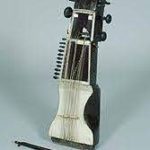
Introduction
Sarangi comes with a rich background of Indian musical tradition. Earlier, it was extensively used as a folk instrument. The short-necked fiddle fretless, bowed string instrument from the Indian subcontinent. This is the most versatile instrument. It can create every shades of musical notes which accompany with vocal music of any classical Indian musical gharana like dhrupad, khayal, thumri, tappa, bhajan, ghazal, with exact texture and techniques.
The old traditional instrument has been used in classical music from the seventeenth century onwards. Later in 19th century it was accompanied with dance performance. The name of Sarangi brings a lot of interesting arguments. According to some it comes from either Sarang in Sanskrit meaning ‘spotted deer’ or some says Sarangi derives its name from the bow of lord Vishnu and probably as it is played with a bow it is named as Sarangi. A different link says Sarangi is a combination of two words ‘seh’(Persian equivalent of three) and ‘rangi’ (Persian equivalent of coloured) corrupted as Sarangi.
Feature of Sarangi
With the box-like shape Sarangi divided into three hollow chambers. It typically has three main strings and sometimes a fourth string is used as a drone. The main parts are called pet (stomach), chaati (chest) and magaj (brain). The length of the the unique instrument can be either 2ft to 2.25ft approx. Weights about 2kgs. It has three melody strings made of gut. Cheddar or tun wood is preferred to make a this instrument. The second option teak or mango wood. The seventeen sympathetic strings are made of steel. The instrument is held vertically while playing.
The musical notes are played on the melody strings with the fingers of the left hand, while different chord combinations are made on the chikari strings to produce an ethereal sound. The sarangi has many variations in its construction across India, but one constant remains – it’s played without any interference from any part of our body other than our hands!
Conclusion:
This is a short and sweet article about the sarangi with some interesting facts. We hope you enjoyed it! To learn more, check out our website. Thank you for reading and good luck with your music!






